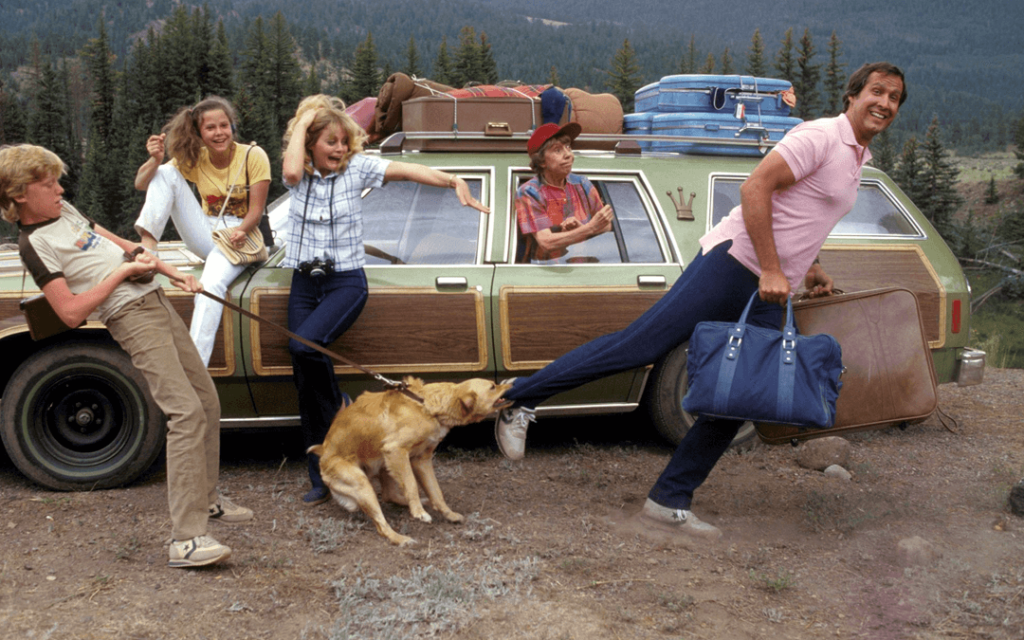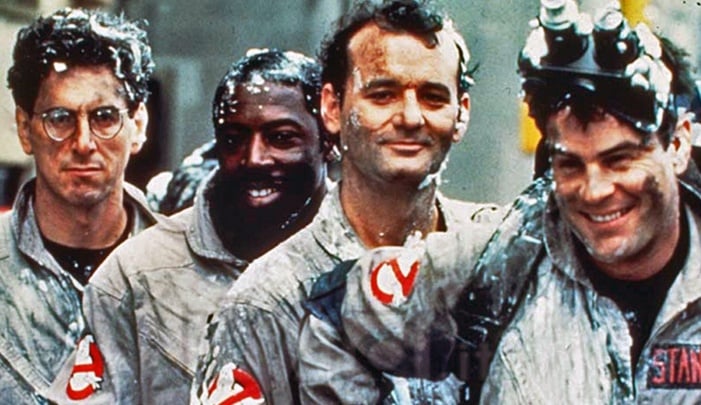‘Ghostbusters: Afterlife’: The sequel we’ve all been waiting for?
November 24, 2021
It’s not likely that during the shooting of Ghostbusters in 1984 that the cast and crew realized they were creating something spectacular that would spawn generations of fans, the creation of three sequels, send careers into superstardom, and inspire endless merchandising. In fact, they were struggling to get it made in time for their promised June release.
But 37 years later and a release date pushed multiple times due to COVID-19, Ghostbusters: Afterlife has hit theaters and is filled to the brim with nostalgia. Co-writer and director Jason Reitman (known for Up in the Air and Juno, and also the son of Ghostbusters and Ghostbusters II director, Ivan Reitman) had even stated in a 2019 interview, “This is going to be a love letter to Ghostbusters. I love this franchise. I grew up watching it.” Not to mention he was on set during the making of the original.
Also written by Gil Kenan and based on the characters created by Dan Aykroyd and Harold Ramis, Ghostbusters: Afterlife brings onboard new cast members Carrie Coon, Mckenna Grace, Finn Wolfhard, and Paul Rudd, along with some familiar cameos.
A two-hour nostalgic ride
Ghostbusters: Afterlife has so many familiarities to the original film that fans will see it as that aforementioned love letter, while some aspects are so different that it feels fresh. But before we get into the new film, let’s explore its origins.
The 1984 feature film is hard to define because it falls in the genres of science fiction, fantasy, and supernatural. Yet, the leads all have a comedy background; Aykroyd and Murray on Saturday Night Live, Ramis on SCTV, and Reitman had just directed Meatballs and Stripes.
The original concept stemmed from the mind of Dan Aykroyd, who had a fascination with ghosts and wrote a story that took place on different worlds and had a more serious tone overall. Once Reitman and Ramis took an interest, they revamped the story to the version we’re more familiar with today. When Murray came on, he notoriously changed his lines — in fact, Reitman has said that almost all of Murray’s lines in the movie are improvised.
When the film was released in June 1984, it spent weeks at number one and became an instant classic. With VHS coming into people’s homes, kids could now watch their video cassettes over and over again until the tape wore out.
Going back to the genre that defines Ghostbusters, the film has a way of meeting all four quadrants referenced in the movie industry and is a high-concept idea that makes it easy to explain. What makes Ghostbusters stand out is that it’s also fun. It knows what kind of movie it is, recognizes universal themes, and builds-in exciting elements that drive the story. It’s a hero’s journey of three people (ultimately four) who get knocked down and crawl their way into success as both the government and ghosts try to take them down.
Merchandising was another major aspect of the film becoming a classic. Who wouldn’t want a proton pack, a ghost trap, or the Ecto-1? My seven-year-old son plays with both the new versions of this and the toys I played with when I was a kid. He was also a Ghostbuster last Halloween. I was a Venkman kid, he loves Egon.
That’s the classic. What about the two sequels?
The road from Ghostbusters (1984) to Ghostbusters: Afterlife
It’s near impossible to recreate the magic of what makes a film beloved. The films that followed Ghostbusters tried meet this challenge but didn’t quite succeed. It’s nothing on the quality of any of the movies, it’s hard to meet those kinds of expectations — something writers should be aware of if asked to adapt a screenplay from a book or write a sequel.
Ghostbusters II, written by Aykroyd and Ramis, was still fun and entertaining, but the message was too on the nose and the character arcs were limiting. Yet, it’s a perfectly acceptable sequel offering the quirkiness of the Ghostbusters trying to find success amid several litigious lawsuits stemming from their saving New York in 1984. The team is amicable yet broken apart.
While enjoyable, and yes, I do like the movie and its memorable quotes are spoken between friends who also liked it, Ghostbusters II feels forced and doesn’t hold the same affection as the original.
Ghostbusters (2016), written by Katie Dippold and Paul Feig, was blanketed with controversy and comparison. 32 years after the original and 27 years after the sequel, this version was meant to reboot the franchise. In all fairness, reboots were ramping up during this time. The Batman and Spiderman characters were finding success as reboots, as were films like Creed (which was sort of a Rocky-story reboot), Beauty and the Beast (which went from animated to live-action), and Jurassic Kingdom, which was attempting a sort-of reboot of the previous films.
Why not Ghostbusters?
I enjoyed this film too for the same reasons I liked Ghostbusters II — fun and entertaining. The biggest controversy other than rebooting the classic film was that they turned the four male Ghostbusters into four female Ghostbusters (still don’t understand the controversy). All the comedy elements were there too, including three of the four leads being Saturday Night Live alum — Kristen Wiig, Kate McKinnon and Leslie Jones — and Melissa McCarthy, who had an Oscar® nomination for her comedic role in Bridesmaids.
The concept was the same though. Kicked out of their prestigious positions at the university level, three brilliant paranormal scientists open their own ghost-busting business and find that evil is poised to take over New York. There was something strange in the neighborhood, so who were you going to call?
The film didn’t land though, and the box office was below the previous films so the reboot failed at its launch. Like Ghostbusters II, it just couldn’t capture the magic of the original. Overall, the summer of 2016 was considered a bust at the box office with one report noting that “every week felt like the equivalent of reheated leftovers.” Audiences were finding entertainment elsewhere, including Netflix where a little show called Stranger Things premiered (four days after Ghostbusters) giving viewers the 1980s nostalgia they craved.
Another lesson for writers — timing is everything.
The third try
What makes Ghostbusters: Afterlife different than the other sequels? For starters, unlike the previous films, the main characters are children. This harkens back to popular 1980s films like The Goonies and goes along with popular modern-day entertainment like Stranger Things that puts youngsters into the main roles. It also feels like the original film, following similar characters and concepts, only now they are in a small Oklahoma town and not New York City.
Ghostbusters: Afterlife follows a single mother and her two children who head to Oklahoma where the matriarch’s deceased father left them a plot of land. We learn very quickly that this is Dr. Egon Spengler’s land and the town considered him a crazy dirt farmer. When his family arrives, the two children (played by Finn Wolfhard and Grace Mckenna) are pulled into the supernatural world and must finish the ghost busting of Gozer that still threatens the existence of the world.
Time will tell whether the film meets the same fate as the other sequels and it's hard to determine whether this will capture the imaginations of a new audience in the same way the original film had, or be destined to be just another sequel that failed to live up to the hype.
It is apparent how Kenan and Reitman wove the magic of the original into this story and have passed the torch onto a new generation of Ghostbusters, and this nostalgic two-hour adventure seems to be an appropriate ending to a thirty-seven-year-old saga. But is it the end, though? Or will the world expect another reboot or sequel based on the cherished classic supernatural-fantasy-action-comedy-science-fiction film?
Ghostbusters: Afterlife is currently in theaters.
Written by: Steven Hartman
Steven Hartman is an award-winning, optioned screenwriter. He was a Top 5 Finalist in Big Break’s Historical Category in 2019 and won Best Action/Adventure in Script Summit’s Screenplay Competition in 2021. He holds a Bachelor of Arts degree from Columbia College and had internships at Jerry Bruckheimer Films and Village Roadshow Pictures. Steve is a full-time writer and creative video producer by day and a screenwriter and novelist by night.- Topics:
- Discussing TV & Film



